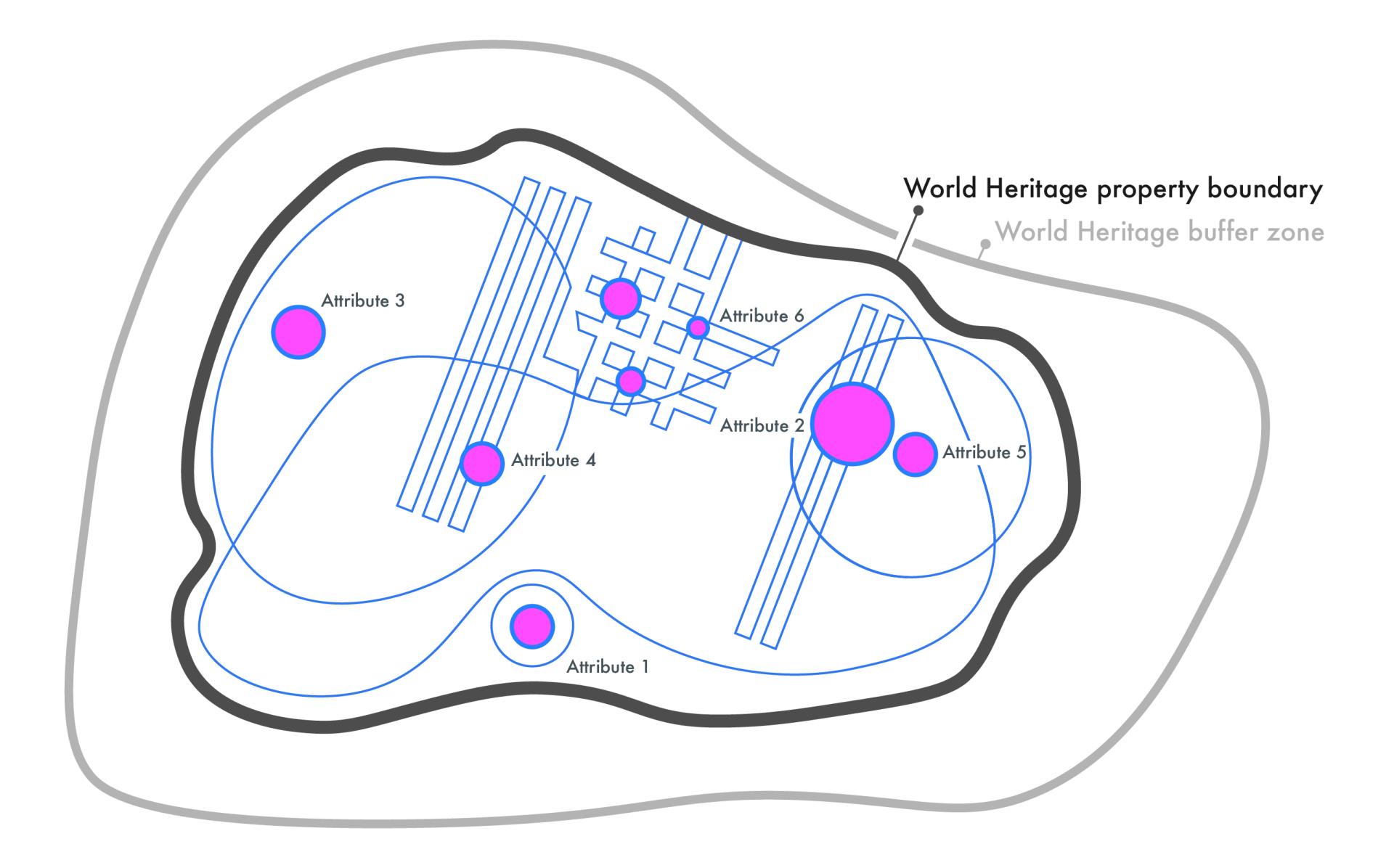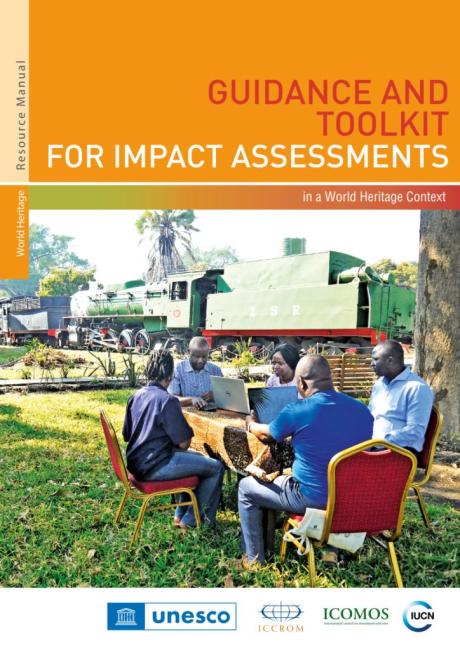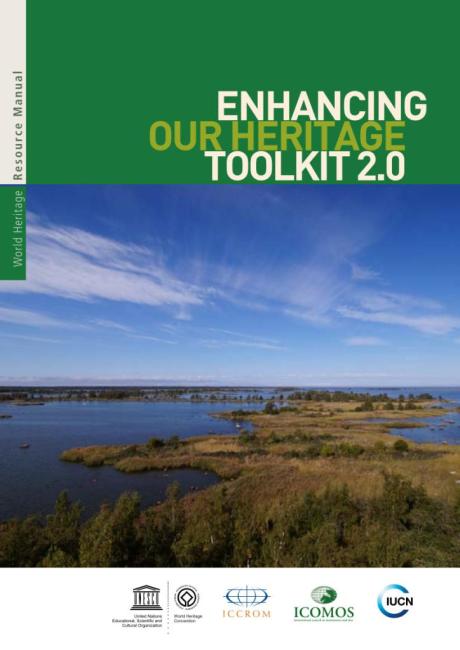Boundaries, buffer zones and the wider setting
- Boundaries of World Heritage properties should be delineated to include all attributes that convey their OUV for their effective protection and management.
- The size and delineation of the property’s boundary are determinant to ensuring its integrity.
- Areas within the boundaries need to be equipped with legal protection measures that ensure the protection of the attributes.
- Buffer zones are areas that provide an added layer of protection for the
World Heritage property
A cultural, natural or mixed heritage place inscribed on the World Heritage List and therefore considered to be of OUV for humanity. The responsibility for nominating a property to the World Heritage List falls upon the State(s) Party(ies) where it is located. The World Heritage Committee decides whether a property should be inscribed on the World Heritage List, taking into account the technical recommendations of the Advisory Bodies following rigorous evaluation processes.
When used as a general term, World Heritage refers to all the natural, cultural and mixed properties inscribed on the World Heritage List. through complementary legal and/or customary restrictions placed on its use and development to prevent and minimize the impacts of factors originating from outside the heritage place. - The wider setting may relate to the property’s topography, natural and cultural environment, and elements such as infrastructure, land-use patterns, spatial organization, and visual relationships. It may also include related social and cultural practices, economic processes and other intangible dimensions of heritage such as perceptions and associations.
- The concept of the wider setting empowers managers to consider factors affecting World Heritage properties regardless of their origin and to work collaboratively with other actors on an integrated approach to planning and management to ensure that potential negative impacts are avoided, while enabling those which are positive.
The delineation of the boundary of a heritage place is an essential requirement for effective protection and management. It is important for the boundary to be drawn on a logical basis that is easy to understand on the ground, helping to identify the heritage place as a distinct entity. This section outlines the issues that should be taken into consideration when decisions are being made about the boundary of a
World Heritage property
A cultural, natural or mixed heritage place inscribed on the World Heritage List and therefore considered to be of OUV for humanity. The responsibility for nominating a property to the World Heritage List falls upon the State(s) Party(ies) where it is located. The World Heritage Committee decides whether a property should be inscribed on the World Heritage List, taking into account the technical recommendations of the Advisory Bodies following rigorous evaluation processes.
When used as a general term, World Heritage refers to all the natural, cultural and mixed properties inscribed on the World Heritage List.
. Often the boundary was delineated a long time ago, and problems have arisen that could be resolved by revising it. For World Heritage, boundaries should be delineated to ensure that all attributes that convey their OUV are included within the property. Boundaries should be defined through participatory processes, with the full and effective participation of different rights-holders, thus ensuring respect of their rights, strengthening community support and preventing potential disputes about how the property is to be protected. Free, prior and informed consent of Indigenous Peoples must be obtained when the delineation of the boundary of property affects their territories.
In cases where a review shows that the boundaries are no longer effective, and a boundary modification is needed to strengthen its integrity, the concerned State Party must make such a request through the official processes defined in the Operational Guidelines. A relatively simple process is established for a minor boundary modification, while a significant boundary modification must follow the procedure as a new nomination to ensure that new boundaries fully respond to and protect the OUV (see Operational Guidelines, paragraph 165).

Figure 3.6 All the attributes conveying OUV should be included within the boundary of the property where its wholeness needs to be considered and is equipped with legal and regulatory measures to ensure its protection.
In general, similar requirements apply when officially designating a heritage place for World Heritage or at a local, regional, national or other international level. However, three aspects need to be specifically considered when delineating the boundaries of a
World Heritage property
A cultural, natural or mixed heritage place inscribed on the World Heritage List and therefore considered to be of OUV for humanity. The responsibility for nominating a property to the World Heritage List falls upon the State(s) Party(ies) where it is located. The World Heritage Committee decides whether a property should be inscribed on the World Heritage List, taking into account the technical recommendations of the Advisory Bodies following rigorous evaluation processes.
When used as a general term, World Heritage refers to all the natural, cultural and mixed properties inscribed on the World Heritage List.
:
- all the attributes conveying OUV should be included within the boundary of the property;
- the integrity of the property has to be considered in terms of its the wholeness and include an analysis of threats;
- the area within the boundaries needs to have legal and regulatory measures that ensure the long-term protection of the property.
Having a clear understanding of the values and attributes of a heritage place is a necessary starting point for establishing adequate boundaries. This will ensure that all the important attributes are included within the area that will be officially designated as heritage. Mapping the attributes of the property can help define its boundaries or assess if existing ones are adequate. Identifying and mapping physical elements and features offers a good start, after which considerations of where other types of attributes occur should be added. For processes and intangible attributes (such as practices or visual or functional relationships), it is necessary to understand where they take place and their spatial requirements. For example, it is important to include the water surface and underground catchment area for a cave or karst property or include a pilgrimage route with ritual stopping points within a sacred landscape.
When the setting is an integral part of the OUV of the
World Heritage property
A cultural, natural or mixed heritage place inscribed on the World Heritage List and therefore considered to be of OUV for humanity. The responsibility for nominating a property to the World Heritage List falls upon the State(s) Party(ies) where it is located. The World Heritage Committee decides whether a property should be inscribed on the World Heritage List, taking into account the technical recommendations of the Advisory Bodies following rigorous evaluation processes.
When used as a general term, World Heritage refers to all the natural, cultural and mixed properties inscribed on the World Heritage List.
, ideally it should also be included within its boundaries. For example, the boundaries of a military fort, where the strategic location is part of its heritage values, should include the surrounding mountain range. In some cases, it is also advisable to include areas where additional attributes that could reinforce the integrity of the place may be discovered through future research. For example, an archaeological site should include unexcavated areas when it is likely that further archaeological features could be discovered there. Some heritage places are dependent on specific visual relationships with their setting; in cases where it is impossible to include an entire viewshed within the property, because of its large scale, a well-designed buffer zone may provide additional protection. In the case of cities and settlements, taking the historic urban landscape approach which recommends to consider all the different layers of the city, with both tangible and intangible processes can be useful.
Boundaries need to include whole attributes. Cutting across a lake or through an individual building or city block, can pose many problems for managers who then need to manage that attribute. The size and delineation of the property’s boundary is also important to ensure the integrity of the heritage place. This is particularly the case with natural properties, where the viability of certain species may require large ecosystems and where properties need to minimize the effects of fragmented or linear boundaries. Size can also be important for cultural properties to ensure the inclusion of dynamic functions and relationships between attributes, for example, in the case of a traditional irrigation system within a cultural landscape or a large-scale industrial complex. When a single large boundary is not appropriate because the attributes are geographically disconnected and distant from one another, then the property will be listed as a serial property on the World Heritage List.
Areas that do not include attributes that convey the OUV of the property, nor are essential to its integrity, should generally be excluded. Ill-defined boundaries can make a
World Heritage property
A cultural, natural or mixed heritage place inscribed on the World Heritage List and therefore considered to be of OUV for humanity. The responsibility for nominating a property to the World Heritage List falls upon the State(s) Party(ies) where it is located. The World Heritage Committee decides whether a property should be inscribed on the World Heritage List, taking into account the technical recommendations of the Advisory Bodies following rigorous evaluation processes.
When used as a general term, World Heritage refers to all the natural, cultural and mixed properties inscribed on the World Heritage List.
more vulnerable by overstretching limited management capacity or by including factors that cause negative impacts within it, for instance, areas of incompatible development or inappropriate resource use. Including inappropriate areas within the
World Heritage property
A cultural, natural or mixed heritage place inscribed on the World Heritage List and therefore considered to be of OUV for humanity. The responsibility for nominating a property to the World Heritage List falls upon the State(s) Party(ies) where it is located. The World Heritage Committee decides whether a property should be inscribed on the World Heritage List, taking into account the technical recommendations of the Advisory Bodies following rigorous evaluation processes.
When used as a general term, World Heritage refers to all the natural, cultural and mixed properties inscribed on the World Heritage List.
may also hinder legitimate development and use.
Boundaries should also be defined from a protection perspective, in the sense of how the
World Heritage property
A cultural, natural or mixed heritage place inscribed on the World Heritage List and therefore considered to be of OUV for humanity. The responsibility for nominating a property to the World Heritage List falls upon the State(s) Party(ies) where it is located. The World Heritage Committee decides whether a property should be inscribed on the World Heritage List, taking into account the technical recommendations of the Advisory Bodies following rigorous evaluation processes.
When used as a general term, World Heritage refers to all the natural, cultural and mixed properties inscribed on the World Heritage List.
is to be protected and from what. In practice, the delineation of boundaries will also be influenced by other considerations such as sovereignty, land tenure, existing rights, or legal requirements. Boundaries must also be defined in relation to legislative, regulatory, and administrative arrangements that can provide a protective status to the property and be designated accordingly. Sometimes legislation may influence the delineation of the boundary of the
World Heritage property
A cultural, natural or mixed heritage place inscribed on the World Heritage List and therefore considered to be of OUV for humanity. The responsibility for nominating a property to the World Heritage List falls upon the State(s) Party(ies) where it is located. The World Heritage Committee decides whether a property should be inscribed on the World Heritage List, taking into account the technical recommendations of the Advisory Bodies following rigorous evaluation processes.
When used as a general term, World Heritage refers to all the natural, cultural and mixed properties inscribed on the World Heritage List.
; for instance, when the boundary of a monument is already defined at the national level by a legally defined distance surrounding the building.
Intricate or convoluted boundaries can make it difficult for people to know and easily identify them on the ground. The physical nature of the boundaries can be equally important: drawing lines on the basis of landforms, ridgelines, or other natural or human-made features can ensure the inclusion of fully functioning ecological areas. Clear boundaries can also help people to identify them, particularly in areas where factors such as illegal logging or urbanization are threatening to encroach on the heritage place. It is more effective to work with the topographical, and ecological features and the existing material fabric of the property.
When there are multiple designations at the same place, there may be different sets of boundaries. At the international level, a
World Heritage property
A cultural, natural or mixed heritage place inscribed on the World Heritage List and therefore considered to be of OUV for humanity. The responsibility for nominating a property to the World Heritage List falls upon the State(s) Party(ies) where it is located. The World Heritage Committee decides whether a property should be inscribed on the World Heritage List, taking into account the technical recommendations of the Advisory Bodies following rigorous evaluation processes.
When used as a general term, World Heritage refers to all the natural, cultural and mixed properties inscribed on the World Heritage List.
inscribed for its geological values may also be designated as a global Geopark or Biosphere Reserve; a World Heritage cultural landscape may also be designated as a Globally Important Agricultural Heritage Site. The property may also have other designations at the national or local levels. In such cases, there may be overlapping boundaries with different regulations and legislations applied. These need to be carefully considered to ensure that they do not create conflict but instead offer compatible support to each other.
The representation of the boundaries of a
World Heritage property
A cultural, natural or mixed heritage place inscribed on the World Heritage List and therefore considered to be of OUV for humanity. The responsibility for nominating a property to the World Heritage List falls upon the State(s) Party(ies) where it is located. The World Heritage Committee decides whether a property should be inscribed on the World Heritage List, taking into account the technical recommendations of the Advisory Bodies following rigorous evaluation processes.
When used as a general term, World Heritage refers to all the natural, cultural and mixed properties inscribed on the World Heritage List.
, of its buffer zone and of other international or national protective designations, requires cartography at an adequate scale and level of detail. The maps should be generated in relation to the nature of the property, its size and attributes. For larger properties there might be the need for a set of maps at a larger scale that describe in more detail the delineation of boundaries in relation to physiographic features, cadastral subdivisions, and administrative limits. In this way, it is easier to understand the rationale for delineating boundaries of the property and its buffer zone, to define the objectives of the additional layer of protection provided by the buffer zone and related measures, and, finally, to communicate them to all relevant actors.
Finally, it is key to recognize that management does not stop where the boundary of the property falls but includes a series of protective layers that ensure its interconnections at different spatial scales and which are essential to guide the management of the heritage place over time. For World Heritage properties, it reinforces an integrated approach to planning and management that goes beyond the property to include any buffer zone, as well as the wider setting.
In addition to drawing boundaries around the
World Heritage property
A cultural, natural or mixed heritage place inscribed on the World Heritage List and therefore considered to be of OUV for humanity. The responsibility for nominating a property to the World Heritage List falls upon the State(s) Party(ies) where it is located. The World Heritage Committee decides whether a property should be inscribed on the World Heritage List, taking into account the technical recommendations of the Advisory Bodies following rigorous evaluation processes.
When used as a general term, World Heritage refers to all the natural, cultural and mixed properties inscribed on the World Heritage List.
, many countries have mechanisms to protect their surroundings or to designate wider areas as an added layer of protection to the property because those areas can have a profound influence over its management. For World Heritage properties, these are called buffer zones but similar mechanisms exist in the legislation of many countries under different designations and terminology. For World Heritage, the designation of
a buffer zone is strongly encouraged and, if not included at the time of its nomination, justification for why a buffer zone is not needed is required. The purpose of a buffer zone is to give an added layer of protection to the
World Heritage property
A cultural, natural or mixed heritage place inscribed on the World Heritage List and therefore considered to be of OUV for humanity. The responsibility for nominating a property to the World Heritage List falls upon the State(s) Party(ies) where it is located. The World Heritage Committee decides whether a property should be inscribed on the World Heritage List, taking into account the technical recommendations of the Advisory Bodies following rigorous evaluation processes.
When used as a general term, World Heritage refers to all the natural, cultural and mixed properties inscribed on the World Heritage List.
by defining an area around it which has complementary legal and/or customary restrictions placed on its use and development. Therefore, a buffer zone helps to respond to factors originating beyond the property’s boundary and complements the protection and management mechanisms put in place for the area of the
World Heritage property
A cultural, natural or mixed heritage place inscribed on the World Heritage List and therefore considered to be of OUV for humanity. The responsibility for nominating a property to the World Heritage List falls upon the State(s) Party(ies) where it is located. The World Heritage Committee decides whether a property should be inscribed on the World Heritage List, taking into account the technical recommendations of the Advisory Bodies following rigorous evaluation processes.
When used as a general term, World Heritage refers to all the natural, cultural and mixed properties inscribed on the World Heritage List.
. This will have implications for identifying who has a mandate to manage the heritage place as well as the buffer zone, who has jurisdiction over certain areas and what governance arrangements are needed.
The delineation of a buffer zone on its own is insufficient to provide added protection; what really matters is how the buffer zone helps to protect the
World Heritage property
A cultural, natural or mixed heritage place inscribed on the World Heritage List and therefore considered to be of OUV for humanity. The responsibility for nominating a property to the World Heritage List falls upon the State(s) Party(ies) where it is located. The World Heritage Committee decides whether a property should be inscribed on the World Heritage List, taking into account the technical recommendations of the Advisory Bodies following rigorous evaluation processes.
When used as a general term, World Heritage refers to all the natural, cultural and mixed properties inscribed on the World Heritage List.
in practice. If buffer zones are spatially defined on a map but not accompanied by complementary regulations – or those regulations are not applied – they fail their purpose. Sometimes, defining the buffer zone so that it coincides with another existing designations, such as a conservation area, means it can take advantage
of the protective measures already in place for those areas, or by using spatial planning mechanisms such as zoning or land-use plans. This is a very pragmatic approach that automatically ensures that the buffer zone can be clearly managed. However, caution should be taken to ensure the difference between the
World Heritage property
A cultural, natural or mixed heritage place inscribed on the World Heritage List and therefore considered to be of OUV for humanity. The responsibility for nominating a property to the World Heritage List falls upon the State(s) Party(ies) where it is located. The World Heritage Committee decides whether a property should be inscribed on the World Heritage List, taking into account the technical recommendations of the Advisory Bodies following rigorous evaluation processes.
When used as a general term, World Heritage refers to all the natural, cultural and mixed properties inscribed on the World Heritage List.
and buffer zone is clear on paper and on the ground and that the regulations used to control the use and development in the buffer zone is sufficient to ensure that it acts as an added layer of protection to the property. It is important for the purposes of the buffer zone to be clearly identified and mirrored in the regulations used for protection.

Figure 3.7 The construction of wind turbines or industrial facilities located outside the property may still result in indirect impacts such as the obstruction of an important viewshed or increasing air and water pollution in the ecosystem.
In some countries, the delineation of the buffer zone may be determined by a legally prescribed distance from the heritage place, for example, an area extending out 200 metres from a designated monument. Such a rigid approach to defining buffer zones may not be sufficient to respond to factors that could affect the property. It is advisable to evaluate the adequateness of the buffer zone and change its boundaries if necessary. Such processes require the State Party to submit a request for a minor modification to the boundaries of the buffer zone (see Operational Guidelines, paragraphs 163-164). It is worth noting that any change to a buffer zone, no matter how extensive, is considered a minor boundary modification so involves a simplified process. This offers the scope to strengthen protection and management mechanisms post-inscription.
Buffer zones should be seen as more than just mechanisms to isolate the property from external factors, otherwise there is a risk of preventing positive interactions that benefit the heritage. Good management of buffer zones can also provide a place for complementary activities, such as the local community carrying out traditional agriculture, or visitors enjoying heritage interpretation. For instance, well-managed buffer zones can provide sustainable resource use which benefits local communities, especially when this might not be desirable within the
World Heritage property
A cultural, natural or mixed heritage place inscribed on the World Heritage List and therefore considered to be of OUV for humanity. The responsibility for nominating a property to the World Heritage List falls upon the State(s) Party(ies) where it is located. The World Heritage Committee decides whether a property should be inscribed on the World Heritage List, taking into account the technical recommendations of the Advisory Bodies following rigorous evaluation processes.
When used as a general term, World Heritage refers to all the natural, cultural and mixed properties inscribed on the World Heritage List.
itself. They can also have an important connectivity function helping to link ecosystems and habitats across whole landscapes, which can facilitate natural processes for wildlife with large range needs. In this regard, buffer zones can be a powerful mechanism as part of climate change mitigation and adaptation strategies responding to biome shifts of fauna, flora and habitats. Equally, this connectivity function
can be critical for serial World Heritage properties, both natural and cultural.
Buffer zones cannot protect a property from all threats, since sometimes these originate far away from the
World Heritage property
A cultural, natural or mixed heritage place inscribed on the World Heritage List and therefore considered to be of OUV for humanity. The responsibility for nominating a property to the World Heritage List falls upon the State(s) Party(ies) where it is located. The World Heritage Committee decides whether a property should be inscribed on the World Heritage List, taking into account the technical recommendations of the Advisory Bodies following rigorous evaluation processes.
When used as a general term, World Heritage refers to all the natural, cultural and mixed properties inscribed on the World Heritage List.
and new factors can emerge long after the delineation of boundaries and buffer zones. In general, management of buffer zones is challenging as the institutional mandate often falls to different institutions than those responsible for the management of the
World Heritage property
A cultural, natural or mixed heritage place inscribed on the World Heritage List and therefore considered to be of OUV for humanity. The responsibility for nominating a property to the World Heritage List falls upon the State(s) Party(ies) where it is located. The World Heritage Committee decides whether a property should be inscribed on the World Heritage List, taking into account the technical recommendations of the Advisory Bodies following rigorous evaluation processes.
When used as a general term, World Heritage refers to all the natural, cultural and mixed properties inscribed on the World Heritage List.
and different actors may be involved with overlapping or conflicting responsibilities. Therefore, effective governance arrangements and coordination must be ensured between those managing and involved with the
World Heritage property
A cultural, natural or mixed heritage place inscribed on the World Heritage List and therefore considered to be of OUV for humanity. The responsibility for nominating a property to the World Heritage List falls upon the State(s) Party(ies) where it is located. The World Heritage Committee decides whether a property should be inscribed on the World Heritage List, taking into account the technical recommendations of the Advisory Bodies following rigorous evaluation processes.
When used as a general term, World Heritage refers to all the natural, cultural and mixed properties inscribed on the World Heritage List.
, the buffer zone and its wider setting.
The Operational Guidelines promote an integrated approach to planning and management that goes beyond the property to include any buffer zone(s), as well as the wider setting, to guide the evolution of properties over time and to ensure maintenance of all aspects of their OUV. Unlike a buffer zone, the wider setting is not a formally defined spatial entity, nor does it have a precise definition. However, it can be useful to think of the wider setting as those aspects that may relate to the property’s topography, natural and cultural environment, and other elements such as infrastructure, land-use patterns, spatial organization, and visual relationships. It may also include related social and cultural practices, economic processes and other intangible dimensions of heritage such as perceptions and associations.
In fact, the area of the wider setting that needs consideration might change according to the task in hand, for example, how the wider setting is defined will be different when carrying out daily management tasks, completing an impact assessment for a specific development project, or designing a DRM plan. A temporal dimension may also apply to the wider setting, for example, ensuring seasonal migrations of birdlife may require protective measures in areas well outside the heritage place itself and its buffer zone.
This approach to management and the concept of the wider setting are crucial when assessing the positive and negative impacts of factors that originate beyond the property and its buffer zone. Regardless of their distance from the heritage place, a range of factors in the wider setting can impact the OUV of a
World Heritage property
A cultural, natural or mixed heritage place inscribed on the World Heritage List and therefore considered to be of OUV for humanity. The responsibility for nominating a property to the World Heritage List falls upon the State(s) Party(ies) where it is located. The World Heritage Committee decides whether a property should be inscribed on the World Heritage List, taking into account the technical recommendations of the Advisory Bodies following rigorous evaluation processes.
When used as a general term, World Heritage refers to all the natural, cultural and mixed properties inscribed on the World Heritage List.
. This may be the construction of high-rise buildings or wind turbines which will disturb the spirit and feeling in a sacred site, or the construction of tourism facilities and transportation infrastructure that might bring increased tourist pressure to a historic town or protected area.
This concept of the wider setting and the integrated management approach behind it, empowers managers to consider factors affecting World Heritage properties regardless of their origin and to work collaboratively with other actors to ensure that potential negative impacts are avoided, while enabling those which are positive.
- Were the boundaries of the property defined in relation to the identification and mapping of the attributes that convey its OUV?
- Are the boundaries and size of the property adequate to protect those attributes? Do the boundaries and size of the property ensure functional, spatial and/or visual connectivity between the attributes?
- Are the boundaries and size of the property adequate to protect other important values of the property? Is the boundary of the
World Heritage property
A cultural, natural or mixed heritage place inscribed on the World Heritage List and therefore considered to be of OUV for humanity. The responsibility for nominating a property to the World Heritage List falls upon the State(s) Party(ies) where it is located. The World Heritage Committee decides whether a property should be inscribed on the World Heritage List, taking into account the technical recommendations of the Advisory Bodies following rigorous evaluation processes.
When used as a general term, World Heritage refers to all the natural, cultural and mixed properties inscribed on the World Heritage List. logically drawn and easy to identify on the ground by all actors? - Is there a map clearly identifying the property boundaries and buffer zone readily available?
- Does the boundary and/or buffer zone contain appropriate legal or regulatory protection measures that apply to the attributes of the
World Heritage property
A cultural, natural or mixed heritage place inscribed on the World Heritage List and therefore considered to be of OUV for humanity. The responsibility for nominating a property to the World Heritage List falls upon the State(s) Party(ies) where it is located. The World Heritage Committee decides whether a property should be inscribed on the World Heritage List, taking into account the technical recommendations of the Advisory Bodies following rigorous evaluation processes.
When used as a general term, World Heritage refers to all the natural, cultural and mixed properties inscribed on the World Heritage List. ? - If there are other designations (at the international, national or local levels), are there issues deriving from different boundaries associated with those other designations?
- Is the buffer zone(s) large enough to address threats originating from external interactions that may negatively affect the property?
- Have large-scale spatial and functional dynamics important to maintain the values and integrity of the property been identified?
- Are the boundaries of the
World Heritage property
A cultural, natural or mixed heritage place inscribed on the World Heritage List and therefore considered to be of OUV for humanity. The responsibility for nominating a property to the World Heritage List falls upon the State(s) Party(ies) where it is located. The World Heritage Committee decides whether a property should be inscribed on the World Heritage List, taking into account the technical recommendations of the Advisory Bodies following rigorous evaluation processes.
When used as a general term, World Heritage refers to all the natural, cultural and mixed properties inscribed on the World Heritage List. shared and updated in various geographic information systems and the World Heritage Online Map Platform?
- UNESCO (2009). World Heritage Papers 25, World Heritage and Buffer Zones; Patrimoine mondial et zones tampons International Expert Meeting on World Heritage and Buffer Zones Davos, Switzerland 11 –14 March 2008, Paris, UNESCO.
- IUCN (2016). Managing MIDAS: harmonising the management of Multi-Internationally Designated Areas. Gland (Switzerland), IUCN (Swizerland).
- IUCN (2016). ICCAs and Overlapping Protected Areas: Fostering Conservation Synergies and Social Reconciliation. Tehran, CENEST/ICCA Consortium.
- UNESCO (2024). Operational Guidelines for the implementation of the
World Heritage Convention
The Convention Concerning the Protection of the World Cultural and Natural Heritage is an international treaty adopted by the UN in 1972 that defines the kind of natural or cultural sites which can be considered for inscription on the World Heritage List for their Outstanding Universal Value for all humankind. Commonly known as the World Heritage Convention, it establishes how the international community as a whole is responsible for
the protection of such heritage and sets out the duties of States Parties in identifying potential sites that may be eligible for inscription onto the World Heritage List and their role in protecting and preserving them. By signing the Convention, each country pledges to conserve not only the sites situated on its territory that have been recognized as being of Outstanding Universal Value, but also to protect its national heritage and to be involved in international efforts to protect, conserve and promote the heritage of humankind. , paragraphs 87-107. - UNESCO, ICCROM, ICOMOS, IUCN (2023). Tool 3. Boundaries, Buffer Zones and the Wider Setting, in Enhancing Our Heritage Toolkit 2.0, pp. 40-45, Paris, UNESCO.
- UNESCO Sites Navigator.
- UNESCO Urban Heritage Atlas.



